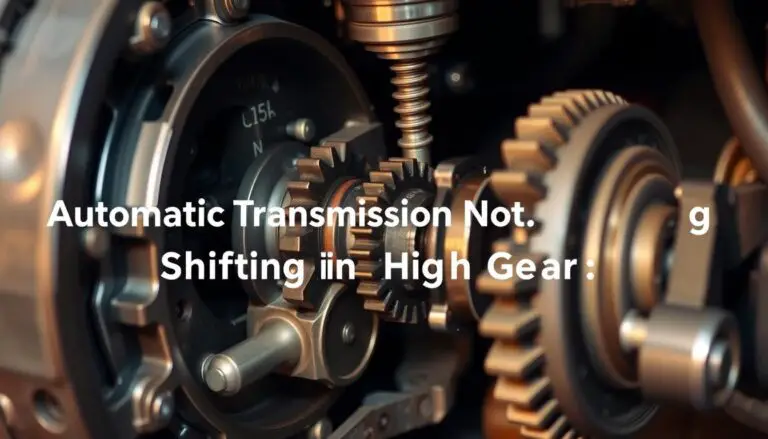A malfunctioning car fan poses a significant risk, potentially causing overheating and damage to your vehicle’s cooling system. When the fan persists in operation, it not only depletes the battery but also signals an underlying issue that necessitates immediate attention.
Troubleshooting this problem requires a comprehensive understanding of the cooling system’s components and the identification of potential causes. This comprehensive guide will navigate you through the diagnostic and potential corrective measures, ensuring the optimal functioning of your vehicle’s cooling system.
Key Takeaways
- Understanding the role of the car fan in the cooling system
- Identifying common causes for a car fan not turning off
- Steps to troubleshoot the cooling system
- Potential fixes for a malfunctioning car fan
- Importance of maintaining the cooling system
Understanding Your Car’s Cooling System
To diagnose issues with your car fan, it’s essential to comprehend the basics of your car’s cooling system. The cooling system is designed to regulate engine temperature, and the fan plays a crucial role in this process.

How the Cooling Fan Works
The cooling fan is typically activated when the engine reaches a certain temperature. It’s usually controlled by a temperature sensor, relay, or the Engine Control Unit (ECU). When the engine is hot, the fan turns on to draw air through the radiator, thus cooling the engine down.
Normal Fan Operation vs. Problematic Behavior
Normally, the fan operates in cycles, turning on and off as needed based on the engine’s temperature. If the fan runs continuously or fails to turn off, it may indicate a problem. This could be due to a faulty temperature sensor, defective relay, or issues with the ECU or wiring.
Reasons Why Your Car Fan Won’t Turn Off
A car fan that persists in operation, despite attempts to shut it off, signals a deeper issue within the vehicle’s cooling apparatus. Grasping the underlying causes is imperative for effective diagnosis and rectification.
Faulty Temperature Sensor
A faulty temperature sensor can precipitate the cooling fan’s incessant operation. This sensor, responsible for monitoring the engine’s thermal state, transmits critical signals to the ECU, governing the fan’s activation or deactivation. An anomalous sensor reading can induce perpetual fan operation.
Defective Relay or Fan Switch
A defective relay or fan switch frequently underpins this problem. The relay, functioning as a control switch, dictates the fan’s operational state. Its failure can result in the fan’s persistent activation. Analogously, a malfunctioning fan switch can perpetuate the fan’s operation.

ECU/Computer Issues
ECU/computer issues also contribute to the fan’s unrelenting operation. The ECU, orchestrating various engine functionalities, including the cooling fan’s operation, is susceptible to software malfunctions or hardware failures. Such maladies can disrupt the fan’s normal functioning.
Wiring Problems and Short Circuits
Wiring problems and short circuits can also be the culprit. Corroded or damaged wiring can create aberrant electrical conduits, leading to the fan’s continuous operation. A thorough examination of the wiring for any signs of damage or corrosion is critical.
Pinpointing the exact cause necessitates a methodical investigation, scrutinizing each potential source until the root issue is identified and rectified.
Potential Consequences of an Always-Running Fan
A car fan persistently operating can have profound effects on your vehicle’s health and your financial well-being. The continuous operation of the fan precipitates a cascade of issues, impacting your vehicle’s performance and longevity.
Battery Drain and Electrical System Impact
The immediate consequence of an always-running fan is battery drain. The fan’s persistent operation rapidly depletes your car’s battery, potentially leaving you stranded. Excessive electrical load can induce voltage fluctuations, endangering critical components such as the alternator and electronic control units. Experts warn that a faulty cooling fan relay can cause the fan to run continuously, leading to battery drain and other electrical system issues identify bad cooling fan relay.
Premature Fan Motor Failure
The premature failure of the fan motor is another significant consequence. Continuous operation without adequate rest periods causes the motor to overheat and wear out faster than anticipated. This not only incurs the cost of replacing the fan motor but also compromises the cooling it provides, potentially leading to engine overheating.
Addressing the issue of an always-running fan promptly is essential to avoid these costly consequences. By understanding the potential impacts, you can take proactive measures to diagnose and rectify the problem, ensuring your vehicle’s longevity and performance.
Diagnosing the Problem
Diagnosing a car fan that refuses to turn off necessitates an examination of several critical components and systems. This meticulous process is essential for pinpointing the underlying cause, thus ensuring the implementation of appropriate repairs.
Visual Inspection Steps
A visual inspection emerges as a pivotal initial step in the diagnostic process. It entails scrutinizing various components for any evidence of damage or deterioration.
Checking for Visible Damage
Initiate by scrutinizing the fan, its housing, and adjacent components for any visible damage. Look for physical damage indicators such as cracks or dents, and verify the integrity of all connections. For further insights into common malfunctions, refer to this resource.
Inspecting Coolant Levels
Low coolant levels can precipitate continuous fan operation. Verify the coolant reservoir’s level against the recommended standard. If it’s below the recommended level, replenish it and observe the fan’s subsequent behavior.
Using Diagnostic Tools
Diagnostic tools offer invaluable insights into the fan’s functionality. Employ a multimeter to assess the voltage supply to the fan and its circuit. A scan tool can further reveal any trouble codes pertinent to the cooling system or fan operation.
Testing Electrical Components
Electrical component testing is indispensable in resolving fan-related issues. Inspect the fan relay, temperature sensor, and wiring for any anomalies. Utilize a multimeter to verify continuity and voltage drops across these components.
Adhering to these diagnostic steps enables a systematic approach to identifying the issue with your car’s fan. Whether the solution lies in a straightforward adjustment or a more intricate repair, identifying the root cause is the initial step towards rectification.
Quick Fixes You Can Try
The scenario where a car’s fan refuses to disengage can be both vexing and urgent. Fortunately, several expedient remedies exist to address this predicament. Prior to embarking on more intricate repairs, it is prudent to attempt some elementary solutions. These may not only expedite the resolution but also potentially mitigate financial outlay.
Safety Precautions Before Starting
Initiate by ensuring your safety through the deactivation of the engine and the engagement of the parking brake. Don the protective garb of gloves and safety glasses to avert potential injuries. A consultation with your vehicle’s manual is advisable to glean specific safety protocols.
Resetting the ECU
Resetting the Engine Control Unit (ECU) constitutes a straightforward initial step. This entails disconnecting the vehicle’s battery for a duration of approximately 30 minutes, allowing the ECU to reset. This procedure can rectify software-related malfunctions. Post-battery reconnection, verify if the fan’s continuous operation persists.
Checking and Replacing Fuses
A blown fuse can precipitate fan malfunction. Investigate the fuse box for any blown fuses pertinent to the cooling fan circuit. If a blown fuse is identified, substitute it with a new fuse of identical amperage rating. This action often suffices to rectify the issue.
Inspecting Wiring Connections
Examine the wiring connections associated with the cooling fan for any evidence of damage or corrosion. Utilize a wire brush to clean any corroded connections and verify their secure attachment. Faulty or loose wiring can induce continuous fan operation.
Temporary Disconnection Methods
In scenarios where the fan’s operation poses immediate threats, such as battery drain, temporary disconnection may be necessary. Identify the fan relay or fuse and remove it to halt the fan’s operation. This serves as a temporary expedient and necessitates subsequent thorough diagnosis and repair.
By implementing these expedient solutions, you may successfully address the issue with your vehicle’s fan. Yet, if the problem endures, it is imperative to seek professional assistance for a comprehensive diagnosis and repair of any underlying issues.
Step-by-Step Guide to Replacing Common Faulty Components
Replacing faulty components is a critical step in resolving the issue of a continuously running car fan. This guide will navigate you through the process of identifying and replacing common parts that may be causing the problem.
Replacing a Temperature Sensor
Locating the Sensor
The temperature sensor is typically situated near the thermostat or on the engine block. Consult your car’s manual or seek a sensor connected to the engine’s cooling system.
Removal and Installation Process
To replace the temperature sensor, first, disconnect the electrical connector. Then, use a wrench to loosen and remove the sensor. Install the new sensor by tightening it securely and reconnecting the electrical connector. Ensure the new sensor is properly seated to avoid inaccurate readings.
Replacing a Fan Relay
Finding the Relay Box
The relay box is usually located in the engine compartment or under the dashboard. Check your car’s manual for the exact location.
Testing and Swapping Relays
To test the fan relay, swap it with a similar relay in the box. If the fan turns off after swapping, the original relay was faulty. Replace it with a new one. Be cautious when handling electrical components to avoid damage or shock.
Addressing Wiring Issues
Wiring issues can cause the fan to stay on due to short circuits or damaged wires. Inspect the wiring for any signs of damage or wear. Repair or replace damaged wiring as needed, ensuring all connections are secure and not corroded.
By following these steps, you can identify and replace common faulty components causing your car fan to stay on. Remember to consult your car’s manual for specific instructions and safety precautions.
When to Seek Professional Help
Complex cooling fan issues frequently necessitate the specialized knowledge of a professional mechanic. If, after attempting the troubleshooting steps previously discussed, the issue remains unresolved, it is imperative to seek professional assistance.
Signs of Complex Electrical Issues
Be vigilant for the following indicators of complex electrical problems:
- Frequent blown fuses
- Intermittent fan operation
- Dashboard warning lights that persist
These symptoms signify a more intricate issue, necessitating professional diagnosis.
Cost Estimates for Professional Repairs
The cost of professional repairs can vary significantly, influenced by the nature of the issue. Here are some estimated costs:
- Diagnostic services: $100-$200
- Replacement of faulty components: $200-$500
Obtaining a detailed estimate from your mechanic is crucial before embarking on repairs.
Conclusion
The imperative to rectify a malfunctioning car fan, which persists in an operational state, is paramount to avert the depletion of battery reserves, the premature degradation of the fan motor, and the potential for electrical system malfunctions. This discourse has delved into the intricacies of the cooling system’s functionality, the myriad causes of such malfunctions, and the methodologies for diagnosing and rectifying these issues.
Through comprehension of the cooling fan’s operational dynamics and the identification of potential defects such as a malfunctioning temperature sensor, a defective relay, or wiring anomalies, one can initiate corrective measures. Immediate resolutions, such as resetting the Engine Control Unit (ECU), verifying the integrity of fuses, and scrutinizing wiring connections, may suffice to rectify the issue. In instances where the problem proves more intractable, the necessity for component replacement or professional intervention may arise.
Efficient troubleshooting necessitates a blend of diligence and a methodical approach. Adherence to the outlined steps enables the identification and resolution of the problem, thus ensuring the optimal functioning of the vehicle’s electrical system. This treatise’s culmination is to equip you with the requisite knowledge to address this prevalent issue with confidence.
FAQ
What are the common causes of a car fan not turning off?
The primary culprits include a malfunctioning temperature sensor, a defective relay or fan switch, and issues with the ECU/computer. Wiring problems or short circuits also play a significant role.
How do I diagnose the issue with my car’s cooling fan?
Begin with a thorough visual inspection to identify any visible damage. Next, check the coolant levels. Utilize diagnostic tools to test the electrical components, ensuring a comprehensive assessment.
Can a car fan that won’t turn off drain my battery?
Absolutely, a continuously operating fan can lead to battery drain, significantly impacting your vehicle’s electrical system.
What are the potential consequences of not addressing a car fan that won’t turn off?
Ignoring the issue can result in premature failure of the fan motor, battery drain, and damage to your vehicle’s electrical system.
How do I replace a faulty temperature sensor?
To replace the sensor, first locate it. Then, follow the removal and installation procedures meticulously. Ensure proper connection to avoid future malfunctions.
When should I seek professional help for a car fan issue?
If you encounter signs of complex electrical issues or are uncertain about the diagnosis or repair process, it is advisable to seek professional assistance.
What is the cost estimate for professional repairs for a car fan issue?
The cost estimate is variable, influenced by the cause of the issue, labor costs, and the vehicle type. An accurate quote can only be provided by a professional mechanic.
Can I reset the ECU to fix the car fan issue?
Resetting the ECU may resolve the issue, but it is crucial to follow the correct procedure specific to your vehicle to avoid further complications.
How do I inspect wiring connections for a car fan issue?
Inspect wiring connections by examining them for signs of wear, damage, or corrosion. Ensure all connections are secure to prevent future malfunctions.


